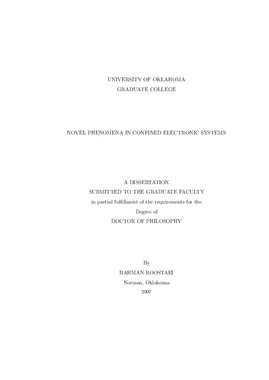| dc.contributor.advisor | Mullen, Kieran J., | en_US |
| dc.contributor.author | Roostaei, Bahman. | en_US |
| dc.date.accessioned | 2013-08-16T12:20:57Z | |
| dc.date.available | 2013-08-16T12:20:57Z | |
| dc.date.issued | 2007 | en_US |
| dc.identifier.uri | https://hdl.handle.net/11244/1281 | |
| dc.description.abstract | Modern experimental methods have made it possible for physicists to investigate matter in extreme conditions. Two of the most extreme conditions are low temperature and low dimensionality. Fabricated semiconductor or metal nano-ring arrays and narrow quantum wells in semiconductor heterostructures at low temperatures provide such an extreme environments for electrons. I will explain these systems in this dissertation. Quantum Wells. In a closely spaced double quantum well (DQW), electrons are thought to form an interlayer coherent state when a perpendicular magnetic field is applied such that the total Landau level filling factor one. The low energy topological excitations of the electron gas in these structures includes charged pseudo-spin vortices and anti-vortices. By calculating the energy per electron and the electron densities in the Hartree-Fock approximation, we show that there are new excited states with interwoven spin and pseudo-spin and that their presence in the system can explain new experimental results. The excitations of DQW's (called merons) also have important effects on transport in these systems. These objects carry charge, vorticity, and electric dipole moment. Disorder is likely to unbind them and allow them to diffuse through the system independently. Due to their different dipole moments, the various types of merons may then in principle be distinguished in transport activation energies by an interlayer bias potential. We explore the dynamics of merons using Chern-Simon theory for quantum Hall systems. We numerically estimate their energies in various circumstances and compare them to the recent experiments. Nano-rings. In this dissertation we also fully analyze the possible phases of a model of singly charged one and two dimensional arrays of rings each having a diameter " 100 nm. Using the Hartree approximation and Monte-Carlo simulations we demonstrate that the electrostatic polarization of these arrays undergoes a quantum phase transition due to quantum mechanical fluctuations. Using a complete finite size scaling analysis for a one dimensional array we show that this phase transition is in the universality class of the transverse field Ising model. Also we will show that an external magnetic field changes the polarization behavior from anti-ferroelectric to ferroelectric due to the Aharanov-Bohm effect. | en_US |
| dc.format.extent | xvi, 147 leaves : | en_US |
| dc.subject | Physics, Condensed Matter. | en_US |
| dc.subject | Engineering, Electronics and Electrical. | en_US |
| dc.subject | Low-dimensional semiconductors. | en_US |
| dc.subject | Quantum wells. | en_US |
| dc.subject | Electrons. | en_US |
| dc.title | Novel phenomena in confined electronic systems. | en_US |
| dc.type | Thesis | en_US |
| dc.thesis.degree | Ph.D. | en_US |
| dc.thesis.degreeDiscipline | Homer L. Dodge Department of Physics and Astronomy | en_US |
| dc.note | Source: Dissertation Abstracts International, Volume: 68-12, Section: B, page: 8087. | en_US |
| dc.note | Adviser: Kieran J. Mullen. | en_US |
| ou.identifier | (UMI)AAI3291240 | en_US |
| ou.group | College of Arts and Sciences::Homer L. Dodge Department of Physics and Astronomy | |
